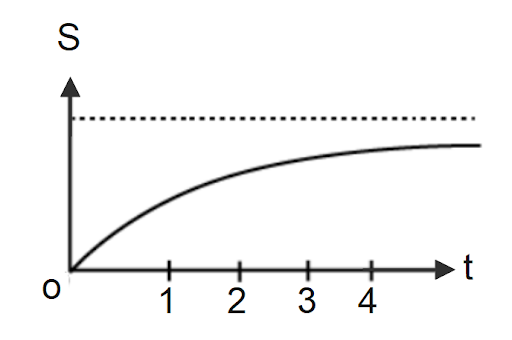
The displacement of a particle as a function of time as shown in the figure. It indicates

A. the particle starts with a certain velocity, but the motion is retarded and finally the particle stops.
B. the velocity of the particle decreases.
C. the acceleration of the particle is in the opposite direction to the velocity.
D. the particle starts with a constant velocity, the motion is accelerated and finally the particle moves with another constant velocity.
Answer
224.7k+ views
Hint: In this question, we are given a figure in which displacement of a particle is shown. We have to choose the option which our figure satisfies. We see that at origin slope is not zero and with the increase in time slope is decreasing. Then we choose the option which our figure satisfies.
Complete step by step solution:
We are given a figure in which the displacement of a particle as a function of time. We know that the slope of the s-t graph represents velocity. Initially at the origin, slope is not zero, so the particle has some initial velocity. With the increasing time we see that the slope is decreasing and finally the slope becomes zero, so the particle stops finally. As the magnitude of the velocity is decreasing, so the velocity and the acceleration will be in opposite directions.
Hence, options A,B and C are correct.
Note: We say that the displacement varies with time or is a function of time t.
We know the equation $d=vt+\dfrac{1}{2}a{{t}^{2}}$$d=vt+\dfrac{1}{2}a{{t}^{2}}$
This clearly shows that the displacement depends upon time.
Complete step by step solution:
We are given a figure in which the displacement of a particle as a function of time. We know that the slope of the s-t graph represents velocity. Initially at the origin, slope is not zero, so the particle has some initial velocity. With the increasing time we see that the slope is decreasing and finally the slope becomes zero, so the particle stops finally. As the magnitude of the velocity is decreasing, so the velocity and the acceleration will be in opposite directions.
Hence, options A,B and C are correct.
Note: We say that the displacement varies with time or is a function of time t.
We know the equation $d=vt+\dfrac{1}{2}a{{t}^{2}}$$d=vt+\dfrac{1}{2}a{{t}^{2}}$
This clearly shows that the displacement depends upon time.
Recently Updated Pages
Uniform Acceleration Explained: Formula, Examples & Graphs

JEE Main 2026 Session 1 Correction Window Started: Check Dates, Edit Link & Fees

JEE Isolation, Preparation and Properties of Non-metals Important Concepts and Tips for Exam Preparation

Isoelectronic Definition in Chemistry: Meaning, Examples & Trends

Ionisation Energy and Ionisation Potential Explained

Iodoform Reactions - Important Concepts and Tips for JEE

Trending doubts
JEE Main 2026: City Intimation Slip and Exam Dates Released, Application Form Closed, Syllabus & Eligibility

JEE Main 2026 Application Login: Direct Link, Registration, Form Fill, and Steps

Understanding the Angle of Deviation in a Prism

How to Convert a Galvanometer into an Ammeter or Voltmeter

Hybridisation in Chemistry – Concept, Types & Applications

Ideal and Non-Ideal Solutions Explained for Class 12 Chemistry

Other Pages
JEE Advanced Marks vs Ranks 2025: Understanding Category-wise Qualifying Marks and Previous Year Cut-offs

Laws of Motion Class 11 Physics Chapter 4 CBSE Notes - 2025-26

Mechanical Properties of Fluids Class 11 Physics Chapter 9 CBSE Notes - 2025-26

Units And Measurements Class 11 Physics Chapter 1 CBSE Notes - 2025-26

JEE Advanced 2026 - Exam Date (Released), Syllabus, Registration, Eligibility, Preparation, and More

JEE Advanced 2026 - Exam Date (Released), Syllabus, Registration, Eligibility, Preparation, and More




